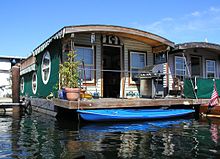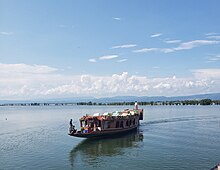
A floating island is a mass of floating aquatic plants, mud, and peat ranging in thickness from several centimeters to a few meters. Sometimes referred to as tussocks, floatons, or suds, floating islands are found in many parts of the world. They exist less commonly as an artificial island. Floating islands are generally found on marshlands, lakes, and similar wetland locations, and can be many hectares in size.

The Kerala backwaters are a network of brackish lagoons and canals lying parallel to the Arabian Sea of the Malabar coast of Kerala state in south-western India. It also includes interconnected lakes, rivers, and inlets, a labyrinthine system formed by more than 900 km (560 mi) of waterways, and sometimes compared to bayous. The network includes five large lakes linked by canals, both man made and natural, fed by 38 rivers, and extending virtually half the length of Kerala state. The backwaters were formed by the action of waves and shore currents creating low barrier islands across the mouths of the many rivers flowing down from the Western Ghats range. In the midst of this landscape there are a number of towns and cities, which serve as the starting and end points of backwater cruises. There are 34 backwaters in Kerala. Out of it, 27 are located either closer to Arabian Sea or parallel to the sea. The remaining 7 are inland navigation routes.

Vembanad is the longest lake in India, as well as the largest in the state of Kerala. The lake has an area of 230 square kilometers and a maximum length of 96.5 km.

Ashtamudi Lake, in the Kollam District of the Indian state of Kerala is a unique wetland ecosystem and a large palm-shaped water body. It is second only in size to the Vembanad estuary ecosystem of the state. Ashtamudi means 'eight hills or peaks' in the local Malayalam language. The name is indicative of the lake's topography with its multiple branches. The lake is also called the gateway to the backwaters of Kerala and is well known for its houseboat and backwater resorts. Ashtamudi Wetland was included in the list of wetlands of international importance, as defined by the Ramsar Convention for the conservation and sustainable utilization of wetlands. Ashtamudi Estuary is the deepest among all the estuaries in Kerala, with a maximum depth of 6.4 meters at the confluence zone.

Kettuvallam is a houseboat widely used in the Indian state of Kerala. These have thatched roof covers over wooden hulls. The traditional kettuvallam is mainly used for promoting Kerala tourism.

Munroe Island or Mundrothuruthu is an inland island group located at the confluence of Ashtamudi Lake and the Kallada River, in Kollam district, Kerala, South India. It is a group of eight small islets comprising a total area of about 13.4 km2. The island, accessible by road, rail and inland water navigation, is about 25 kilometres (16 mi) from Kollam by road, 38 kilometres (24 mi) north from Paravur, 12 kilometres (7.5 mi) west from Kundara and about 25 kilometres (16 mi) from Karunagapally. As of the 2011 Indian census, the administrative village of Mundrothuruth has a total population of 9599, consisting of 4636 males and 4963 females. This island is also known as "Sinking Island of Kerala"

A continuous cruiser licence is a class of boat licence issued on United Kingdom inland waterways under the control of the Canal and River Trust. The term "continuous cruiser" refers specifically to boats and/or owners operating under such licence.

Kerala, a state situated on the tropical Malabar Coast of southwestern India, is one of the most popular tourist destinations in the country. Named as one of the ten paradises of the world by National Geographic Traveler, Kerala is famous especially for its ecotourism initiatives and beautiful backwaters. Its unique culture and traditions, coupled with its varied demography, have made Kerala one of the most popular tourist destinations in the world. Several international agencies ranging from UNESCO to National Geographic have recognised the state's tourism potential. Kerala was named by TIME magazine in 2022 among the 50 extraordinary destinations to explore in its list of the World's Greatest Places. In 2023, Kerala was listed at the 13th spot in The New York Times' annual list of places to visit and was the only tourist destination listed from India.
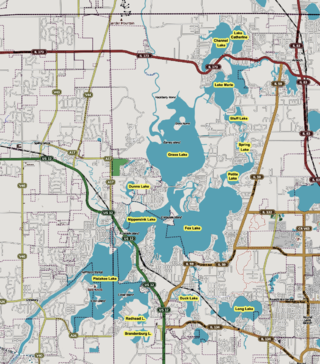
The Chain O'Lakes, or simply "The Chain", is a waterway system in northeast Illinois composed of 15 lakes connected by the Fox River and man-made channels. Encompassing more than 7,100 acres (29 km2) of water, 488 miles (785 km) of shoreline and 45 miles (72 km) of river, the Chain is the busiest inland recreational waterway per acre in the United States.
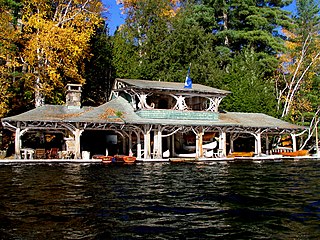
A boathouse is a building especially designed for the storage of boats, normally smaller craft for sports or leisure use. These are typically located on open water, such as on a river. Often the boats stored are rowing boats. Other boats such as punts or small motor boats may also be stored.

The shikara is a type of wooden boat found on Dal Lake and other water bodies of Srinagar in Jammu and Kashmir. Shikaras are of various sizes and are used for multiple purposes, including transportation. A usual shikara seats six people, with the driver paddling at the rear. Like the Venetian gondolas, they are a cultural symbol of Kashmir. Some shikaras are still used for fishing, harvesting aquatic vegetation, and transport, while most are covered with tarpaulins and are used by tourists. A Shikara ride in Dal Lake is a great way to experience the beauty of Dal Lake and get a glimpse into the life of the locals. Some are used as floating homes.

Nautical tourism, also called water tourism, is tourism that combines sailing and boating with vacation and holiday activities. It can be travelling from port to port in a cruise ship, or joining boat-centered events such as regattas or landing a small boat for lunch or other day recreation at specially prepared day boat-landings. It is a form of tourism that is generally more popular in the summertime.

A pontoon boat is a flattish boat that relies on floats to remain buoyant. These pontoons contain much reserve buoyancy and allow designers to create large deck plans fitted with a variety of accommodations including expansive lounge areas, stand-up bars, and sun pads. More horsepower is now able to be applied to the stern due to design improvements. Pontoon boat drafts may be as shallow as eight inches, which reduces risk of running aground and underwater damage; this allows it to come close to shore to pick up and drop off loads.
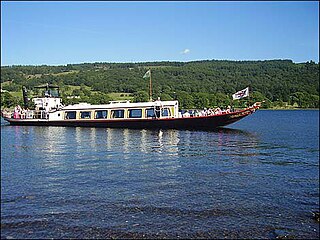
The steam yacht Gondola is a rebuilt Victorian, screw-propelled, steam-powered passenger vessel on Coniston Water, England. Originally launched in 1859, she was built for the steamer service carrying passengers from the Furness Railway and from the Coniston Railway. She was in commercial service until 1936 when she was retired, being converted to a houseboat in 1946. In 1979, by now derelict, she was given a new hull, engine, boiler and most of the superstructure. She is back in service as a passenger boat, still powered by steam and now operated by the National Trust.

The West Coast Canal or National Waterway No 3 is a 205 km (127 mi) long inland navigational route located in Kerala, India, which runs from Kollam to Kottapuram. It was declared a National Waterway in 1993. In addition to the main stretch, Champakara and Udyogmandal canals are navigable and connect the industrial centers of Kochi to Kochi port Inland Waterways Authority of India (IWAI) under the Ministry of Shipping is coordinating the task for developing, monitoring and administering national waterways. It is the first National Waterway in the country with 24-hour navigation facilities along the entire stretch. It has been extended to Kozhikode by the National Waterways Act, 2016. The National Waterway 3 mainly passes through the previous Thiruvananthapuram–Shoranur canal.

Floats are airtight hollow structures, similar to pressure vessels, designed to provide buoyancy in water. Their principal applications are in watercraft hulls, aircraft floats, floating piers, pontoon rhinos, pontoon causeways, and marine engineering applications such as salvage.
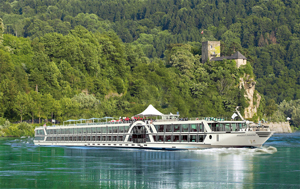
A hotelship is a passenger ship which is used for a period as a hotel. A botel or boatel is a boat that serves as a hotel or hostel. Currently there are few permanent hotel ships. The word is a portmanteau of boat and hotel. Botels may range from small or larger purpose-built or converted boats or other watercraft, to converted ships. They may be permanently moored or grounded, or spend part of the year taking guests on tours. The most famous examples are the Queen Mary, in Long Beach; and the Queen Elizabeth 2, in Dubai. Both ships were originally part of Cunard line. During the 2022 World Cup, Qatar chartered three cruise ships to mitigate accommodation shortages.
Babu Varghese helped to make the South Indian state of Kerala, and in particular the image of houseboats on the Kerala backwaters, a notable tourist destination.
Waterways have always been an important mode of transport in Kerala. The total length of navigable route in Kerala was 1,900 kilometres and the navigable rivers constitute about 54 per cent of the waterways. The 41 West-flowing rivers together with the backwaters are an integrated part of the inland navigation system in Kerala. In Kerala water transportation through these channels are mainly small distant passenger services, informal country boats, freight transportation to PSU's such as Fertilisers and Chemicals Travancore, Kochi etc.
New Yorkers have lived on houseboats since the 19th century, docking across several boroughs. Historically, houseboat dwellers were typically men who worked on barges in the Hudson River. Since the 1940s, houseboat inhabitants have mostly chosen to live aboard for pleasure. Boats offer cheap housing, good views, and privacy. In 1999, it was estimated to be several hundred houseboats in the city.

